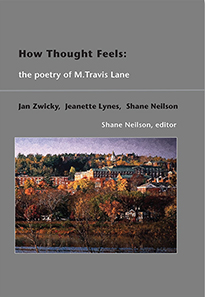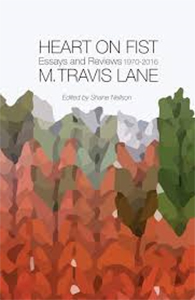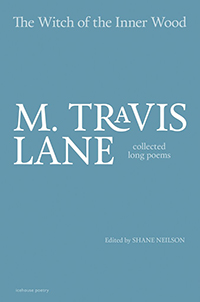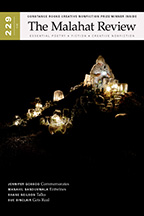Reviews
Poetry Reviews by Kevin McNeilly
M. Travis Lane, The Witch of the Inner Wood: Collected Long Poems, edited by Shane Neilson (Fredericton: Goose Lane, 2016). Hardcover, 377 pp., $40.00.
M. Travis Lane, Heart on Fist: Essays and Reviews 1970-2016, edited by Shane Neilson (Windsor: Palimpsest, 2016). Paperbound, 296 pp., $19.95.
Shane Neilson, editor, How Thought Feels: The Poetry of M. Travis Lane (Victoria: Frog Hollow, 2015). Paperbound, 174 pp., $27.50.
M. Travis Lane’s writing impels and bewitches—often for the same reasons: impels because of her fierce acuity, her unremittingly engaged intelligence as a reviewer and her razor-fine sense of lyric texture as a poet; bewitches with the capaciously melodic cadences of her thinking and with the sustained conceptual resonances of her creative and critical practice. Forty years of published work—gathered and addressed in these three recent, late volumes—offers a window onto the consistently remarkable and wrongfully under-regarded corpus of her poetry and poetics. It is a true pleasure to discover and to re-discover the—Lane wouldn’t like this descriptor—sheer greatness of her talent. Honestly, reading M. Travis Lane pushes me—with a mixture of heart and fist, of kind involvement and stern jostle—to pursue an intensely felt connection, like hers and through hers, to a deeply-sounded and moving experience of meaning in the world, and of the sensual and imaginative heft of words.
 As Lane’s editor, publisher, advocate, curator, apologist, fellow poet, and acolyte, Shane Neilson willingly acknowledges his thorough involvement in these books. His introduction to How Thought Feels—which collects essays on M. Travis Lane’s poetics by him, by Jan Zwicky, and by Jeanette Lynes, along with a compilation (his term) of thematically-arranged slices from Lane’s long poems—begins with a personal account of walking out to visit Lane while he’s on a visit to Fredericton to care for his father. Their relationship, from his side, combines genuine friendship and objective admiration, warmly reciprocated by Lane herself. He describes Lane appearing like a “white-haired sprite” at her door: “’Hello Shane,’ she said, ‘Now come in, come in.’” Nielson positions himself as surrogate reader, sitting on her couch leafing through her publications while she hovers nearby—a detached but palpable presence, at once inviting and formal, close and still proper. Neilson wants to enable her recognition beyond this intimate, critically privileged sequester; “Travis is 80 years old,” he writes in a letter accompanying How Thought Feels: “As a woman who lived in New Brunswick and who published on small presses, she didn’t acquire the attention she deserved in her career.” (All three of these books come in small runs from small presses.) Neilson understands his role as clearing space for Lane’s work to be heard and felt. But his sense of needful discovery persists; he assumes that very few will know who Lane is, or have a sense of the monumentality of her accomplishment. Jan Zwicky describes her surprise at her first encounter with Lane’s work—during a 1989 reading at the University of New Brunswick—when, arriving in what Lane calls a “shabby eastern province,” Zwicky unexpectedly hears a “sharply intelligent, sophisticated” and musically rigorous voice that she characterizes as “an attempt at honest seeing,” in caringly crafted poetry. Jeanette Lynes wants to affirm Lane’s place, when she seems “to have fallen through the cracks” of critical reception, in an “ecological web” of Canadian poetry, a vital “connectedness” to other writers and readers that remains unattended and underappreciated.
As Lane’s editor, publisher, advocate, curator, apologist, fellow poet, and acolyte, Shane Neilson willingly acknowledges his thorough involvement in these books. His introduction to How Thought Feels—which collects essays on M. Travis Lane’s poetics by him, by Jan Zwicky, and by Jeanette Lynes, along with a compilation (his term) of thematically-arranged slices from Lane’s long poems—begins with a personal account of walking out to visit Lane while he’s on a visit to Fredericton to care for his father. Their relationship, from his side, combines genuine friendship and objective admiration, warmly reciprocated by Lane herself. He describes Lane appearing like a “white-haired sprite” at her door: “’Hello Shane,’ she said, ‘Now come in, come in.’” Nielson positions himself as surrogate reader, sitting on her couch leafing through her publications while she hovers nearby—a detached but palpable presence, at once inviting and formal, close and still proper. Neilson wants to enable her recognition beyond this intimate, critically privileged sequester; “Travis is 80 years old,” he writes in a letter accompanying How Thought Feels: “As a woman who lived in New Brunswick and who published on small presses, she didn’t acquire the attention she deserved in her career.” (All three of these books come in small runs from small presses.) Neilson understands his role as clearing space for Lane’s work to be heard and felt. But his sense of needful discovery persists; he assumes that very few will know who Lane is, or have a sense of the monumentality of her accomplishment. Jan Zwicky describes her surprise at her first encounter with Lane’s work—during a 1989 reading at the University of New Brunswick—when, arriving in what Lane calls a “shabby eastern province,” Zwicky unexpectedly hears a “sharply intelligent, sophisticated” and musically rigorous voice that she characterizes as “an attempt at honest seeing,” in caringly crafted poetry. Jeanette Lynes wants to affirm Lane’s place, when she seems “to have fallen through the cracks” of critical reception, in an “ecological web” of Canadian poetry, a vital “connectedness” to other writers and readers that remains unattended and underappreciated.
 Lane’s copious, keenly attentive reviews might represent her own enmeshment in an expansive literary network, although she speaks from one of its more attenuated edges. She positions herself as an informed amateur, an exacting poetic interlocutor who will not suffer incompetence gladly but who also celebrates the weightiness and global reach of real accomplishment: “I review because I love to discover good poetry, to share my pleasures with others, and because thinking about writing that I admire exercises my mind. I also review because I’ve never had a full-time job. Poetry and keeping house have been my life” (“On Reviewing”). The sculptural surety elevating taste to objective standard—she knows clearly what “good” writing is—modulates to a colloquial humility (“I’ve never had…”) that feels more or less characteristic of the regional, of the marginal and the “shabby.” Still, Lane engages with Tomas Tranströmer and Anne Simpson on equal footing: Eurocentric metaphysical grandeur, for her, has no problem coexisting with the world-class compositional acuity of a poet from Antigonish. Redressing such imbalances of reception informs Lane’s project, as reviewer, as much as it does Neilson’s editorial work around Lane herself. Her readings, for example, of what she calls the “unimpoverished” “maximalism” of George Elliott Clarke leverage the wealth and reach of his “Nofaskoshan” style onto a much wider cultural stage. Lane is, in my view and pace Zwicky, no regionalist, at least not in the wheelhouse of James Reaney’s arch formalism or in the mould of E. J. Pratt’s hyperbolic cultural nationalism. Rather, Lane usually takes for granted the attendant worldliness of the writing she encounters: poetry, for her, is poetry, subject to the same acumen and standards no matter where it says it comes from.
Lane’s copious, keenly attentive reviews might represent her own enmeshment in an expansive literary network, although she speaks from one of its more attenuated edges. She positions herself as an informed amateur, an exacting poetic interlocutor who will not suffer incompetence gladly but who also celebrates the weightiness and global reach of real accomplishment: “I review because I love to discover good poetry, to share my pleasures with others, and because thinking about writing that I admire exercises my mind. I also review because I’ve never had a full-time job. Poetry and keeping house have been my life” (“On Reviewing”). The sculptural surety elevating taste to objective standard—she knows clearly what “good” writing is—modulates to a colloquial humility (“I’ve never had…”) that feels more or less characteristic of the regional, of the marginal and the “shabby.” Still, Lane engages with Tomas Tranströmer and Anne Simpson on equal footing: Eurocentric metaphysical grandeur, for her, has no problem coexisting with the world-class compositional acuity of a poet from Antigonish. Redressing such imbalances of reception informs Lane’s project, as reviewer, as much as it does Neilson’s editorial work around Lane herself. Her readings, for example, of what she calls the “unimpoverished” “maximalism” of George Elliott Clarke leverage the wealth and reach of his “Nofaskoshan” style onto a much wider cultural stage. Lane is, in my view and pace Zwicky, no regionalist, at least not in the wheelhouse of James Reaney’s arch formalism or in the mould of E. J. Pratt’s hyperbolic cultural nationalism. Rather, Lane usually takes for granted the attendant worldliness of the writing she encounters: poetry, for her, is poetry, subject to the same acumen and standards no matter where it says it comes from.
It’s not that she ignores the Canadian genetics of much of what she reviews. She repeatedly makes a case for the poetry of unb’s A. G. Bailey, which I have to admit doesn’t convince me; I just don’t hear it. But hearing is exactly the basis of Lane’s globalizing critique: she takes as objective that a genuine musicality in language can bear witness to essential human truth—though her ear, while largely accurate and openly acquisitive, can also be fairly unforgiving. A recalcitrant formalist, she nonetheless decries saccharine aestheticism (the danger of “too much sugar” that renders poetry merely—and this is a recurrent complaint in her criticism—“amusing”). She’s certainly a latter-day Yeatsian modernist, and like Yeats never lets go of a certain difficult version of homecoming, of a capacious but rigorously cultivated place for poetry of tangible value, of “good” work. Her own lines never settle, and words are honed, refigured, prised apart, and revised, articulating a “sleek unsaying” even as they fall into contingent domestic order. “For home,” she writes, “is a place we’ve never been. / We would not be home in it were we there.” Unlike Yeats, Lane is particularly concerned with making space for women’s writing, for poetry by women; her self-description as a housewife (or faculty wife) seems wryly ingenuous, and a large part of her own mythopoeic practice centres on opening up excluded voices (of girls, wives, witches) to audibility. “Homecoming,” the first long poem collected in The Witch of the Inner Wood gathers a set of seasonal “musings” and transplants an Odyssean nostos to “rural New Brunswick” where “there are moose among the olive trees” and where a new Penelope recomposes her Ithaca, repurposing music from quiescent grief. Lane’s poetic homemakers shape, fracture, disrupt and unsettle verbal form to produce alternative lyricisms. Lane listens astutely to the ludic wrangle of Phyllis Webb, to the fraught melodic conviction of Margaret Avison, to the lyric provocations of Paulette Jiles, to distill, to sound and to recuperate, variously, a noisy antiphony of women’s voices. (Oddly absent—unless I have overlooked her—is P. K. Page, who strikes me as an ally in approach and practice for Lane.) Rather than rehearse Lane’s readings of others, though, I want to take a little time to listen to her particular musicality, to substantiate my case for the significance, the cultural weight, of her work. Lane tries to populate her reviews with liberal quotations, “by which you may judge the reviewer,” by seeing and hearing for yourself. Fair enough.
 The Witch of the Inner Wood gathers all of Lane’s long poems (“I propose that a poem which takes at least five minutes to read aloud is long,” she writes), lifted and arranged chronologically from Homecomings (1977) to The All Nighter’s Radio (2010). The earlier work shows the influence of Robert Frost. Her first review to appear in The Fiddlehead in the fall of 1962 was about Frost’s final collection, In the Clearing, and her 1967 doctoral dissertation (for a PhD awarded by Cornell) focused on Frost’s style. The poems tend to be loosely narrative, metrically tight, and voiced through personae, many of them dialogues. While Lane’s mature poems do retain vestigial narratives—“Time,” as she puts it, “is the grammar of our perceptions,” and without some kind of narrative movement, poetry can become “duller to read than a tooth chart”—but they tend to consist of daisy-chained lyrics, progressing through a more associative and surreal time-sense foregoing linear development in favour of more complex and subtle sequencing, a polytemporality. Many of those moments are reflexive, and open up questions around Lane’s own sense of articulate form: “Nothing is sure. A poem speaks / but with a mouth of weather. / Nothing’s clear. / [. . .] Words / can turn upon themselves” (“Six Poems Looking at a Sculpture by Űlker Őzerdem”). Traces of Yeatsian diction persist, along with a sculptural sense of prosody. (Notice how the second and third lines meld firmly into iambic pentameter.) But that monumentality, that assuredness, is broken and offset not only by what Lane’s speaker appears to admit here, that nothing is sure, but also by the offset fracture in the temporal fabric of the foreshortened lines themselves. Pocketed within a longer sequence, this aporia reknits itself, looking to foreclose on its unruly “mouth of weather.” (I need to pause here to note that I had a hard time with the Frost-like datedness of “Red Earth,” particularly around descriptions of Indigenous people: the vocabulary, while attempting to be empathetic [“my white words / go lame”], retains a stereotyping diction of otherness that’s uncomfortable, recalling both the maudlin pathos of Duncan Campbell Scott and the reductive tragic symbolizing of “Indians” traced in Margaret Atwood’s 1972 Survival: “The red earth marks the Indian graves.” Jeanette Lynes attempts to recuperate this poem—voiced through the figure of a disempowered scholar’s wife—as an effort at feminist-ecopoetic engagement, but her argument feels a little forced.)
The Witch of the Inner Wood gathers all of Lane’s long poems (“I propose that a poem which takes at least five minutes to read aloud is long,” she writes), lifted and arranged chronologically from Homecomings (1977) to The All Nighter’s Radio (2010). The earlier work shows the influence of Robert Frost. Her first review to appear in The Fiddlehead in the fall of 1962 was about Frost’s final collection, In the Clearing, and her 1967 doctoral dissertation (for a PhD awarded by Cornell) focused on Frost’s style. The poems tend to be loosely narrative, metrically tight, and voiced through personae, many of them dialogues. While Lane’s mature poems do retain vestigial narratives—“Time,” as she puts it, “is the grammar of our perceptions,” and without some kind of narrative movement, poetry can become “duller to read than a tooth chart”—but they tend to consist of daisy-chained lyrics, progressing through a more associative and surreal time-sense foregoing linear development in favour of more complex and subtle sequencing, a polytemporality. Many of those moments are reflexive, and open up questions around Lane’s own sense of articulate form: “Nothing is sure. A poem speaks / but with a mouth of weather. / Nothing’s clear. / [. . .] Words / can turn upon themselves” (“Six Poems Looking at a Sculpture by Űlker Őzerdem”). Traces of Yeatsian diction persist, along with a sculptural sense of prosody. (Notice how the second and third lines meld firmly into iambic pentameter.) But that monumentality, that assuredness, is broken and offset not only by what Lane’s speaker appears to admit here, that nothing is sure, but also by the offset fracture in the temporal fabric of the foreshortened lines themselves. Pocketed within a longer sequence, this aporia reknits itself, looking to foreclose on its unruly “mouth of weather.” (I need to pause here to note that I had a hard time with the Frost-like datedness of “Red Earth,” particularly around descriptions of Indigenous people: the vocabulary, while attempting to be empathetic [“my white words / go lame”], retains a stereotyping diction of otherness that’s uncomfortable, recalling both the maudlin pathos of Duncan Campbell Scott and the reductive tragic symbolizing of “Indians” traced in Margaret Atwood’s 1972 Survival: “The red earth marks the Indian graves.” Jeanette Lynes attempts to recuperate this poem—voiced through the figure of a disempowered scholar’s wife—as an effort at feminist-ecopoetic engagement, but her argument feels a little forced.)
One of my favourite pieces by Lane is “’Cracked’” a tribute to and reworking of Emily Dickinson; the doubled quotation marks suggest both the artifice of self-fashioning and the gap between word and world that Dickinson seeks to cross, suspended in the contrary hiatus of her own parrhesia: “Daffy with weakness my black self holds / the secret of my strength.” The lovely mishmash of diction floats in an elastic fourteener characteristic of Dickinson’s hymnal-like rhythms; Lane’s lines push at their temporal envelope to suggest a woman’s voice—strong for all its supposed weakness—cracking its container. The textures of pastoral domesticity call Lane’s poet home and out of herself:
Each day
the smells of home-baked bread, sweet ginger,
honeycomb—
the heartless, joyless, juvenile
eternities, bee-lovely,
waft me toward what shores
what tropic luxe,
what paradise?
Dickinson’s metaphysical vocabulary and three- and four-beat lines short-circuit with the sensuous overload in Lane’s rendering of the poem’s material present; the question of where the poem’s imperative nudges her and nudges us remains open, but thick with vitality.
One of the most compelling of Lane’s sequences is “The Witch of the Inner Wood.” As with the other long poems, there is too much to describe, and I can offer only a taste of her writing here (this is the seventh section of forty five):
This lank knot-armed, close-knuckled tree
stands like a marker in the rain,
like some old map.
I read it in the nodes and scars.
I read it in the crawling birds,
the black tarpaper shanties of its worms:
that which endures its little while,
supports, blooms and maintains.
I clear its lower branches with my axe.
Again, we have successive moments reflecting in a tense present tense on the work of making; design unfolds and reshapes itself, balancing intervention with acceptance, craft with humility. Notice the shifting counterpoint of tetrameter, pentameter and hexameter line-envelopes, and the involute consonance and slant-rhyme at play. Writing involves both attentive reading of and accommodation to the descriptive, but also a rigorous, judicious pruning that registers the conversant design of the poet, her capacity to understand the collision of thing and marker, of object rendered meaningful.
Lane unfurls her careful music, an admixture of gathering and letting go:
in coiling, miming loveliness,
and all indifferent maths resigned
into the beauty of the frame
their first design,
that what should be dispersed and lost
should be
upgathered now
in love’s
retarding
skein.
Her long poems offer an extended calculus of the variegated tensions between the given and the artificial, between mimesis and poiesis, between joyful attentiveness to what is and reweaving the skeins of the possible: “These things are light. I weld them into light.” The extensive interlace that Lane’s long-form texts offer up to us testify, at both the large and small scale, to her sustained desire to trace the motile interconnections of the spoken and the felt, of sense and sense. “I want the real…” one of Lane’s personae tells us, and her. Just so.
—Kevin McNeilly









